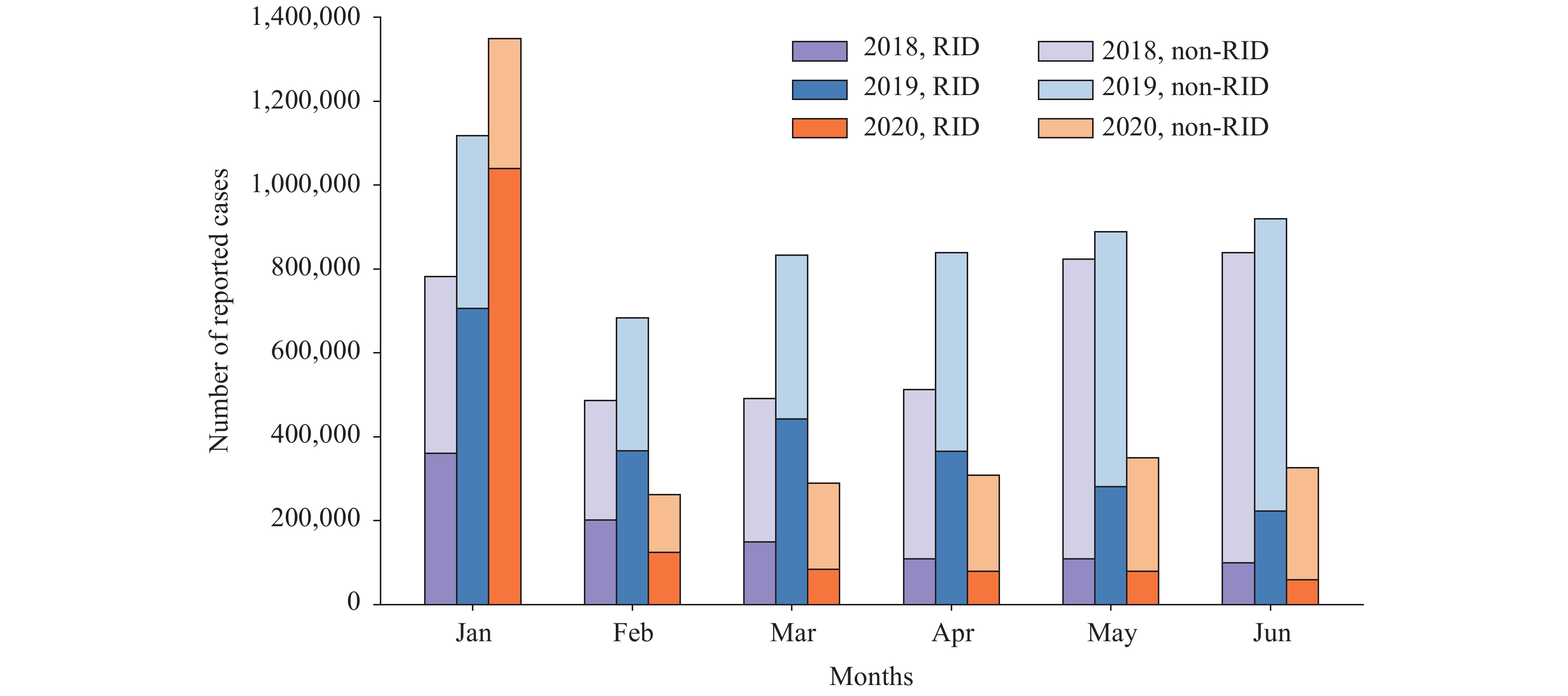-
 Figure 1.
Figure 1.The number of respiratory infectious diseases (RID) and non-respiratory infectious diseases (non-RID) in China from January to June in 2018–2020. Respiratory infectious diseases included measles, tuberculosis, epidemic cerebrospinal meningitis, pertussis, scarlet fever, seasonal influenza, diphtheria, infectious atypical pneumonia, avian influenza H7N9, and coronavirus disease 2019 (COVID-19). Non-respiratory infectious diseases refer to other notifiable infectious diseases except respiratory infectious diseases.
Between January and June 2020, a total of 2,885,058 cases of infectious diseases were reported from China’s National Notifiable Disease Report System (CNNDRS) including 1,463,406 cases of respiratory infectious diseases (RID) and 1,421,652 cases of non-RID. The total number of infectious disease cases in the period of January to June in 2020 was 45.36% lower than in 2019 (5,280,102 cases) and 26.67% lower than in 2018 (3,934,342 cases). For RID in 2020, case numbers were highest in January (1,039,648) and lowest in June (58,310), but the overall total number of cases was 38.59% lower than in 2019 (2,383,019). Since February 2020, the number of RID cases has been at a consistently lower level with monthly reported cases lower than in both 2018 and 2019. Compared with non-RID, the number of RID cases decreased more sharply in 2020, with an especially large decrease of 81.11% in March 2020.
Before the COVID-19 outbreak in 2020, RID maintained a relatively consistent trend during the January to June period. The higher numbers of RID cases in January 2020 was expected because of the contribution of COVID-19. However, this was followed by a dramatic fall in case numbers in February 2020, which was maintained through June of that year. This is due to COVID-19 containment and suppression strategies (1). The implementation of these strategies reduced opportunities for people to move about and interact with one another, which greatly reduced infectious disease transmission.
One such strategy is wearing face masks. Wearing face masks is a simple and effective way to block transmission of COVID-19 (2). In China, all people are strictly required to wear masks to protect themselves from infection and to prevent transmission of infection to others. This strategy cuts off the main transmission route and blocks invisible infection sources of COVID-19 (i.e., asymptomatic persons unaware of their infection). Similarly, wearing face masks also cuts off a main transmission route of other RIDs. According to the National Health Commission’s National Medical Service Situation Report for January to June 2020, the total number of person-visits to medical and health institutions reached 3.27 billion in China, a year-on-year decrease of 21.6% (3). This included 1.43 billion person-visits to hospital, a year-on-year decrease of 21.4% (3). The above factors may have affected the detection and reporting of infectious disease patients in China.
These data indicated that at least some of the containment and suppression strategies (e.g., mask wearing and hand washing) implemented to combat COVID-19 were effective for other RIDs as well. Therefore, their further study and targeted implementation to address future RID outbreaks and/or regular seasonal trends in RIDs should be considered. Adoption of simple changes to everyday life for Chinese people could improve health, wellbeing, and productivity considerably.
Acknowledgments: Authors thank Jennifer M. McGoogan for comments and editing assistance.
Fundings: This work is supported by Special Foundation of Basic Science and Technology Resources Survey of Ministry of Science and Technology of China (No. 2017FY101207) and Application of big data processing and analysis for pathogen monitoring of infectious disease syndromes based on cloud computing technology and construction of sharing platform (No. 2018ZX10713001-012).
Source: Statistics based on onset date, China’s National Notifiable Disease Report System (CNNDRS), 2020.
HTML
| Citation: |


 Download:
Download:





